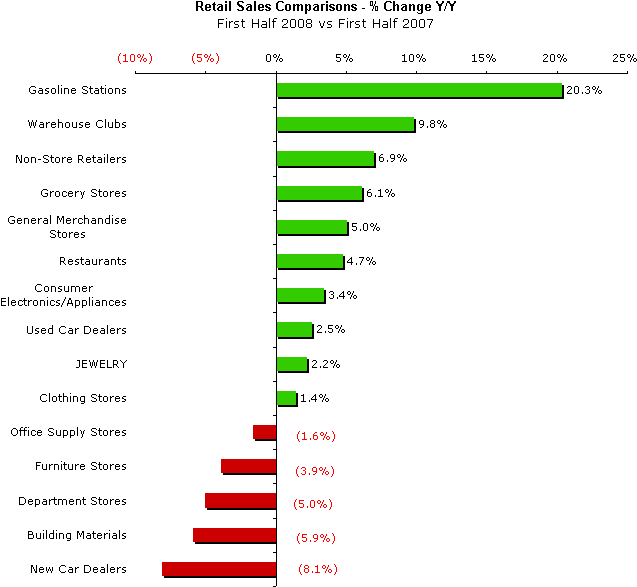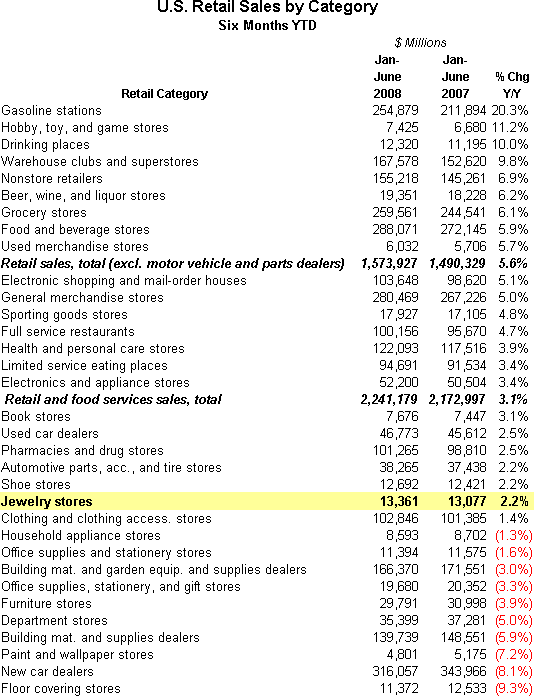IDEX Online Research: Jewelry Demand in the U.S., It Could Be Worse
August 21, 08
It’s been a long six months for jewelers. After a disappointing 2007 holiday selling season, both Valentine’s and Mother’s Day sales in the first half of 2008 were weak. It’s no fun being a jewelry merchant when the economy is weak.
However, before we whine and moan too much, it is helpful to see how our industry is performing versus other key retail segments.
To get right to the punch line: the U.S. jewelry industry really isn’t doing too badly.
After six months, U.S. specialty jewelers’ sales are up by 2.2 percent. While this is below the average for the total retail segment, it is far ahead of a large number of retail categories, especially those which are posting negative sales comparisons. For example, we would not want to be a furniture retailer in today’s economic environment, nor would we want to sell automobiles.
When the economy slows, jewelry demand is usually one of the first categories to feel the weakness. What’s different this time around is that the economic weakness is consumer-led. In prior recent recessions, consumers have continued to spend, with little regard for economic softness. Even when unemployment climbed above 5 percent, it had little impact on consumer spending.
However, what makes the current economically weak period different is this: the factors weighing on economic growth are virtually all related to the consumer market. In the U.S., consumer spending represents about 68 percent of economic productivity, far above most European economies where consumer spending is in the 50-55 percent range. Thus, when U.S. consumers tighten their purse strings, the American economy feels it immediately. We believe that there are six factors which are having a negative impact on the consumer sector of the economy:
- A general lack of economic robustness – The U.S. economy is going through one of its inevitable cycles – the tide comes in, the tide goes out. With economic growth slowing, businesses are spending less, and governments are tightening their belts. This has a ripple effect on the consumer, who had already tightened his or her purse strings.
- A slowdown in the housing market – Not only are home sales slow, but home prices are down. As a result, consumers feel less wealthy. Further, many consumers have used their home as an ATM machine, tapping the increase in equity to fund their free-spending habits. This ATM machine is currently “Out of Service” in today’s economic environment.
- A credit crunch – As a result of bad bank loans – mostly consumer-related mortgages – banks have cut back on credit availability. Jewelers, which depend on third party credit for almost half of their sales, have found more credit applications being turned down by lenders. Consumers can’t get home mortgages, and some are stuck with high interest loans that should have been refinanced in the last cycle.
- Soaring energy prices – As gasoline topped $4 per gallon earlier this summer, consumers moved money from their discretionary budgets –for items like jewelry – to their automobile budgets. Further, heating and other energy-related costs continue to climb.
- Uncertain financial markets – As the financial markets have encountered rough seas as a result of several problems, stock portfolios have declined in value. When people feel less wealthy, they cut back on spending.
- A growing green movement – Because diamonds and gemstones are natural substances, and the mining of these stones is about as eco-friendly as any mining operation, we would think that consumers who want “green” products would consider jewelry to be a “friendly” industry. But the “green” movement has moved beyond green: it is now more about shunning conspicuous consumption and bling. Jewelry is both. Further, consumers appear to be making fewer trips to their local cathedrals of consumption – the shopping mall. Mall traffic is down by at least 4-5 percent in recent months, based on our estimates.
The following graph summarizes retail sales for selected retail categories for the first six months of 2008 compared with the same period in 2007.
 Source: US Dept of Commerce |
While there is some logical explanation for the performance of many of the retail categories shown on the graph – for example, gasoline stations and warehouse club sales are way up and building materials retailers’ sales are down – there are some surprises. Restaurant sales typically soften notably when the economy weakens. However, food price inflation – which has driven up the average ticket – is probably the culprit which is fueling restaurant sales. Consumer electronics sales are up: this is probably due to the popularity of the iPod and other gadgets that capture the imagination of shoppers.
The table below provides a more detailed summary of the size of the retail categories and the percentage change in sales for the first six months of 2008 versus the same period in 2007.
 Source: US Dept of Commerce |